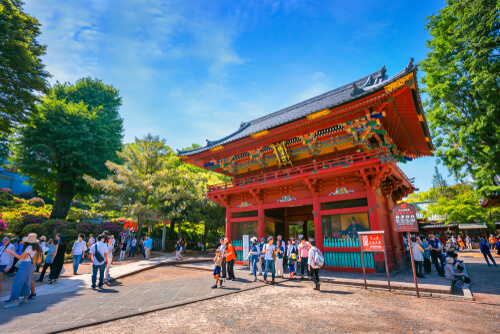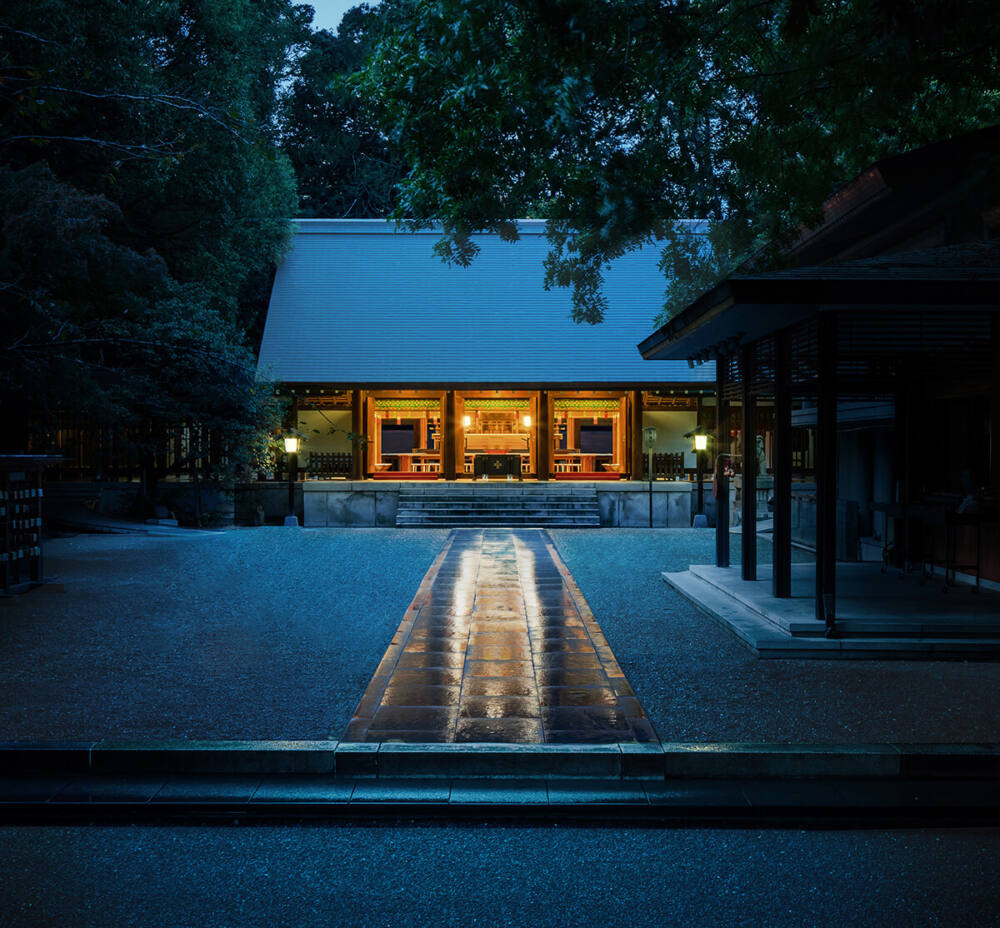Are you looking for the best Tokyo shrines to visit to learn Japanese history? Well, you should visit one of these Japan’s famous shrines that will teach you about the rich culture and heritage of the Japanese.
Dive into Tokyo’s spiritual side! Explore our guide to the most popular shrines and temples, from ancient landmarks to serene gardens. Discover historic sites, experience traditional rituals, and find peace amidst the bustling city.
Page Contents
Which are the best Tokyo shrines?
Some of the best Tokyo shrines are listed below:
- Meiji Shrine
- Nezu Shrine
- Nogi Shrine
- Hanazono Shrine
- Namiyoke Inari Shrine
- Kanda Myojin Shrine
- Yasukuni Shrine
- Hie Shrine
- Related: best museums to visit in Tokyo
Without further ado, let’s check out the best Tokyo shrines to visit to learn Japanese history, below!
Must-visit Tokyo Shrine To Visit To Learn Japanese History
Meiji Jingu Shrine


Meiji Jingu is one of the most famous, sacred and the best Tokyo shrines in Japan.
The shrine is an imperial one that was built as a dedication to the first emperor of modern Japan, Emperor Meiji, and his wife, Empress Shoken.
The shrine has quite marvelous Shinto structures. It is also deeply connected to Japanese history and culture.
The shrine is also quite conveniently located beside Harajuku Station and Yoyogi Park. If you are visiting Tokyo, you really must visit Meiji Jingu Shrine.
It is an extremely popular shrine that sees over three million Japanese people. They come to Meiji Jingu to pray for the coming year and to open the new year.
Also, it is not just praying that people do in this shrine. You will also see that there are so many traditional Japanese weddings happening here.
Meiji is one of the best Tokyo shrines to visit to learn Japanese history.
Opening Hours:
- Monday to Wednesday 6:10am–4:10pm
- Thursdays: 5:40am–4:40pm
- Friday to Sunday: 6:10am–4:10pm
Where: 1-1 Yoyogikamizonocho, Shibuya-ku
Related: Check out where you can find ofuda (omamori) and how to interpret them!
Nezu Shrine

The Nezu Shrine is yet another calm and one of the best Tokyo shrines to visit to learn Japanese history.
This shrine located quite close to the Yanaka neighbourhood and Ueno Park. It is one of the oldest shrines in Tokyo that is quite under the tourist radar. It is one of the best Shinto shrines to learn the culture of Japan.
It is an extremely peaceful place that will bring calmness to your soul. It is also a great place to unwind.
One of the major highlights of Nezu Shrine is its tunnel of torii gates. You can walk through this gate for an ecstatic experience.
However, note that the height might be a problem for tall people, and you may have to squat a little to walk through it. It is one of the best Tokyo shrines to visit to learn Japanese history.
April is one of the best months to visit this shrine. During this month, the place is flooded with pink, purple, and white azalea bushes.
It is one of the most popular places for flower viewing, and during this month, it sees a huge crowd of people. Flower viewing here is so popular that there is an azalea-viewing festival called the Bunkyo Azalea Festival.
Opening Hours:
Monday – Sunday: 6am–5pm
Contact: +81 3-3822-0753
Where: 1-28-9 Nezu, Bunkyo-ku
Related: Get your lucky charms omamori from one of these shrines for the New Year, check it out!
Nogi Shrine

The Nogi shrine is located in the same area as Akasaka. This shrine was built as a mark of dedication to the army general Nogi Maresuke.
After the death of Emperor Meiji in 1912, army general Nogi Maresuke followed the footsteps of his leader in death and committed seppuku, which is also known as harakiri. It is a form of suicide ritual in Japan.
This Japanese temple’s architecture is bold, beautiful and ancient. The shrine is open to visitors all throughout the year, however, the house where the suicide was committed is only open to visitors twice a year.
These two times are on the eve and anniversary of the suicide. The dates for the same are September 12 and 13.
The history of this shrine may be a little dark, but it is one of the most popular places in Tokyo. Nogi is definitely one of the best Tokyo shrines to visit to learn Japanese history.
There is also a very happy reason to visit this place on the fourth Sunday of every month. The shrine organizes treasure hunting at the antique market which is quite fun.
Opening Hours:
Monday – Sunday: 6am–5pm
Contact: +81 3-3478-3001
Where: 8-11-27 Akasaka, Minato-ku
Related: Relax at the best onsens in Hakone!
Hanazono Shrine

The Hanazono Shrine is located only one minute away from the popular Shinjuku Gai, which is known as the “piss alley” and is one of the best Tokyo shrines to visit to learn Japanese history.
The shrine is tucked away behind neon lights, which might put you off in the beginning. However, do not let this dim the expectations you have from this shrine.
When you take this Japanese shrine tour you will yourselves know that this is one of the best Tokyo shrines to visit to learn Japanese history for its rich architecture and historic symbols.
The shrine is bright with its red facade. There are two giant torii gates that look very impressive. There are wide-open grounds as well, which is unlike any other shrine in Tokyo.
The kami of Hanazono Shrine is Inari, who is known as the god of rice and prosperity.
It is because of this reason that this shrine is quite popular amongst businessmen who come here to pray for the success of their business and their prosperity.
Opening Hours:
Monday – Sunday – Open 24 hours
Contact: +81 3-3209-5265
Where: 5-17-3 Shinjuku, Shinjuku-ku
Related: Check out the Tokyo 3-day itinerary, if you’re planning to visit Japan!
Namiyoke Inari Shrine

Namiyoke Inari, when translated, means protection from waves. This name that is given to this shrine is quite fitting as it was built in the mid-1600s at the water’s edge.
So, the name is quite fitting to the shrine’s location. It is one of the best Tokyo shrines to visit to learn Japanese history that offers learning about the cultures as well.
The shrine is situated right next to Tsukiji fish market. This shrine is seen as a guardian of the merchants as well as the entire marketplace.
When you visit the shrine, you can walk around the marketplace and get all sushi-related items. These can be found on the shrine’s grounds as well.
There are also so many beautiful stone sculptures called tsuka here that were built in honor of things of value, including sushi, eggs, shrimp, angler, and clam.
Opening Hours:
Monday – Sunday: 9am–5pm
Contact: +81 3-3541-8451
Where: 6-20-37 Tsukiji, Chuo-ku
Related:Check out the best things to do in Urahara!
Kanda Myojin Shrine

This is one of the oldest shrines in Tokyo, which is believed to have been built in 730. During the Edo period, this shrine was considered to be one of the most important shrines in Tokyo.
Kanda Myojin is most probably because the first shogun of Japan, Tokugawa Ieyasu, paid his respects here. Kanda Myojin is one of the best Tokyo shrines to visit to learn Japanese history.
Most of the people come here to pay their respects and pray to two of the seven Gods of Fortune – Daikokuten, who is known as the god of good fortune, bountiful harvests, and matrimony and Ebisu, who is the god of fisheries and business prosperity.
You will also find good luck charms called omamori here that are known to bless your electronic devices.
Opening Hours:
Monday – Sunday – Open 24 hours
Contact: +81 3-3254-0753
Where: 2-16-2 Sotokanda, Chiyoda-ku
Related: Check out the Top Conveyor Belt Sushi Restaurants in Tokyo for some yummy and authentic sushi!
Yasukuni Shrine

Yasukuni is a very interesting shrine because of the controversy that is attached to it.
In fact, the controversial history of this is one that you will not find anywhere else in the entire Asia-Pacific region.
The shrine was built as a special dedication to all those who died in war for Japan and the Emperor. Yasukani is one of the best Tokyo shrines to visit to learn Japanese history.
As per the Shinto religion, the souls of all those who lost their lives automatically became the kami of the shrine.
This makes the shrine an extremely sacred and holy place for the Japanese. As per the written records, there are more than 2.4 million people who are enshrined here.
Out of these 2.4 million, about 1,000 were considered to be “war criminals”. The controversy is regarding the inclusion of these war criminals in the shrine.
One of the most popular festivals that take place in Yasukuni Shrine is the Mitama Festival. On this day, 30,000 lanterns are lit and hung around the shrine to pay respect to the dead.
Opening Hours:
Monday – Sunday: 6AM to 6PM
Contact: +81 3-3261-8326
Where: 3-1-1 Kudankita, Chiyoda-ku
Related: Wanna get a tattoo? Check out these female-friendly tattoo studios in Tokyo!
Hie Shrine

Hie shrine is located right in between the Imperial Palace grounds and Roppongi and is one of the best Tokyo shrines to visit to learn Japanese history.
The shrine is very popular because of its beautiful red torii gates. The shrine has three entrances and you can enter the shrine through one of them.
When you enter the main shrine, you’ll have to walk through a set of steps that are enclosed in a tunnel of bright red torii gates.
The kami of this shrine is known as Hie-no-kami, and who is considered to be the god of Mt. Hie in Shiga prefecture.
The shrine has two main festivals. The first one is the Sanno Festival, which is known as one of the three greatest festivals in Tokyo. The other one is known as the Jinko Festival.
Opening Hours:
Monday – Sunday : 6am–5pm
Contact: +81 3-3581-2471
Where: 2-10-5 Nagatacho, Chiyoda-ku
Related: Check out the top shopping districts in Tokyo if you’re a shopaholic!
Which is the best Tokyo shrine?
I’ve visited many shrines but Meiji shrine is one of the best Tokyo shrines for its architecture, rich history and heritage.
Meiji shrine is located in Shibuya, Tokyo. This Shinto temple is dedicated to the spirits of the Meiji emperor and his wife, Empress Shōken. During this emperor’s rule Japan flourished boundlessly. This shrine does not contain their graves.
What’s the most popular shrine or temple in Japan?
Ise Grand shrine is the most popular shrine in Japan. It is known to be the spiritual home to Shinto religion and is dated back to the 3rd century.
What is Meiji Jingu shrine known for?
Meiji Jingu is a shrine dedicated to the spirits of Meiji emperor. Under the rule of Emperor Meiji, Japan flourished limitlessly to become one of the world’s major powers. Though this shrine doesn’t contain their graves, it is a tribute to the Meiji emperor.
What are the three sacred Shinto symbols?
The three sacred Shinto symbols sword Kusanagi no Tsurugi (草薙劍), the mirror Yata no Kagami (八咫鏡), and the jewel Yasakani no Magatama (八尺瓊勾玉) from the Imperial Regalia of Japan.
Related: Do you want to know how to rent an apartment in Tokyo, for this guide to get a cool place for yourself!
Learning Japanese History Through Shrines
If you’re a Japanese culture and heritage enthusiast, I’d suggest you go to these best Tokyo shrines to visit to learn Japanese history. It’s a really amazing experience.
Believe me, the whole vibe of these shrines will transport you back in time and make you much closer to Japan.
While the Japanese people are letting go of the practice of daily Shintoism, you will still notice that worship and rituals are deeply embedded in the culture and tradition of Japan
You will also notice that all the shrines have certain specific structural elements. One of these elements that are quite hard to miss is the torii gate. It is a tall vermillion gate that makes for the entrance of the shrine.
Shrines are considered to be extremely sacred, so you will notice that locals often bow down before and after passing through this torii gate to show their respect.
Yet another way to show respect when going to a shrine is by purifying yourself before entering the main hall of the shrine.
You can do this by washing your hands and mouth at a temizuya purification trough. Also, you must have noticed that these shrines have zigzags made of white paper.
These hangings are known as shimenawa and they mark the boundary of something or someplace that is considered to be quite sacred.
Tip: When you visit a shrine, make sure you know what is the proper praying etiquette there.
Here’s what you have to do: shake the rope to ring the bell, throw a coin into the box, bow twice, clap twice, pray, and then bow one last time.
Also Read:





